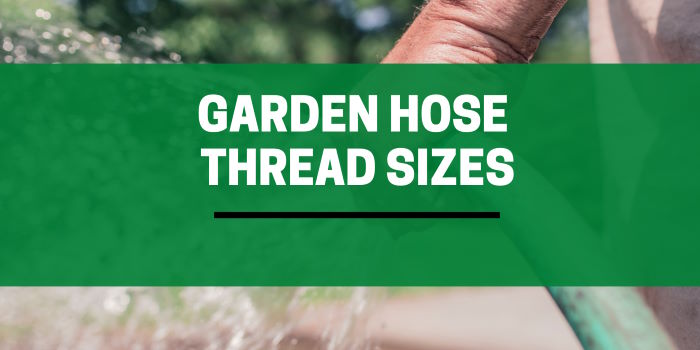
Ever tried connecting your garden hose to an outdoor faucet, only to discover that the threads don’t match up? You’re not alone.
Understanding garden hose thread sizes can be a bit confusing, but this is essential for ensuring proper water flow and preventing leaks.
In this article, we’ll explore everything you need to know about garden hose threads, fittings, and measuring, so you can confidently choose the right hose and connectors for your needs.
Contents
What Is A Garden Hose Thread?
Garden hose threads, often abbreviated as National hose (NH) or Garden Hose Thread (GHT), are a standardized system for connecting hoses to faucets and other attachments.
Threads per inch (TPI) is the number of thread peaks along a one-inch length, while the thread pitch refers to the distance from one peak to another.
Most hoses use a full-form thread design rather than truncated threads. When combined with a quality hose connector gasket inside, a secure and watertight connection is created.
What Are The Standard Garden Hose Fitting Thread Sizes?
Garden hose fittings thread size is the measurement that determines the compatibility of different hose connectors and faucets.
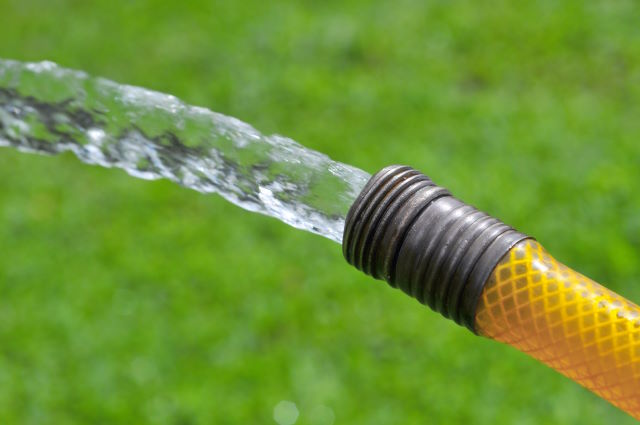
It is usually expressed in inches and refers to the external diameter of the male threads and the internal diameter of the female threads.
The standard thread size for most garden hoses is 3/4-inch GHT, but there are also 1/2-inch, 5/8-inch, and 1-inch options available.
Sizes Of Garden Hose Connectors
Garden hose connectors come in various sizes to accommodate different hose diameters and applications. Common thread sizes include:
- 1/2-inch: Typically found on smaller hoses and some specialty applications
- 5/8-inch: Commonly used for medium-sized hoses
- 3/4-inch: Standard size for most garden hoses and outdoor spigots and hose bibs
- 1-inch: Used for larger hoses and high-flow applications
Thread Details
The common garden hose diameters (below 1 inch) will likely have a 5/8-inch connector. The following details are for the common garden connector threads:
| Hose Diameter (inches) | Connecter Size (inches) | Threads Per Inch (TPI) | Outer Diameter (inches) |
| 1/2 | 5/8 | 11.5 | 1.0625 |
| 3/4 | 5/8 | 11.5 | 1.0625 |
| 5/8 | 5/8 | 11.5 | 1.0625 |
| 1 | 1 | 8 | 1.375 |
| 1 1/2 | 1 1/2 | 9 | 1.990 |
Note that threads per inch is commonly referred to as thread pitch.
Types Of Fittings
There are several types of garden hose fittings, each with its advantages and disadvantages.
Quick-Release Fittings
Quick-release fittings, also known as push-fit or snap-on connectors, are designed for easy attachment and removal.
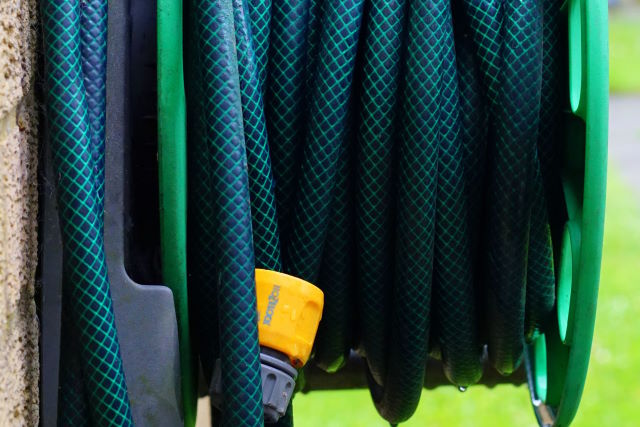
They are particularly useful when switching between different hose attachments, such as nozzles and sprinklers.
Differences In Fitting Material
Fittings can be made from various materials, including brass, plastic, and stainless steel. Brass fittings are known for their durability and resistance to corrosion, while plastic fittings are lightweight and more affordable.
On the other hand, stainless steel fittings offer excellent strength and corrosion resistance but can be more expensive. The choice of material depends on your budget, personal preference, and the specific needs of your garden.
Nozzles & Attachments
There are countless nozzles and attachments available for garden hoses, including spray guns, sprinklers, and soaker hoses.
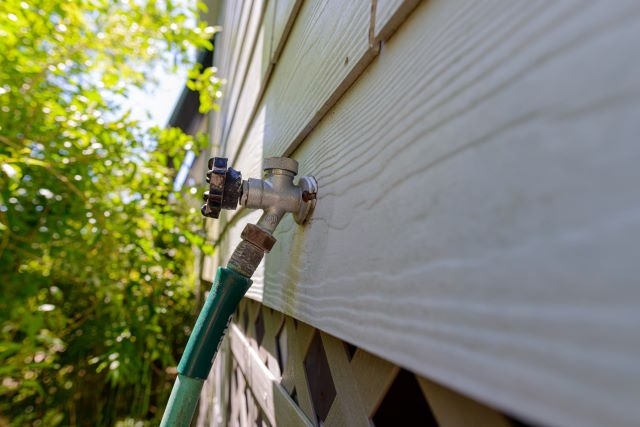
The type of connector you need will depend on the attachment you’re using and the specific task you’re trying to accomplish.
Measuring Your Garden Hose Fittings
Measuring a garden hose fitting is a simple process that can save you a lot of trouble and frustration. Here’s a step-by-step guide:
#1 – Find Out Whether You Need Male Or Female Connectors
You will need to determine whether you need a male or female hose fitting. Male fittings have external threads that screw into female connectors, while female fittings have internal threads that connect to male parts.
#2 – Measure A Male Fitting
If you’re measuring a male hose fitting, use a ruler or tape measure to find the external diameter (the distance across the threads). This measurement will help you identify the correct thread size for your hose.
#3 – Measure A Female Fitting
For female hose fittings, measure the internal diameter (the distance from one thread to another on the inside). This measurement will help you determine the appropriate thread size for your hose attachment.
#4 – Find A Hose With The Correct Size Fittings
Now that you know the thread size you need, you can find a garden hose that will work with your tap and attachments.
What Is A Standard Garden Hose Size?
The standard size for most garden hoses is 3/4-inch GHT, which offers a good balance between water flow and pressure.
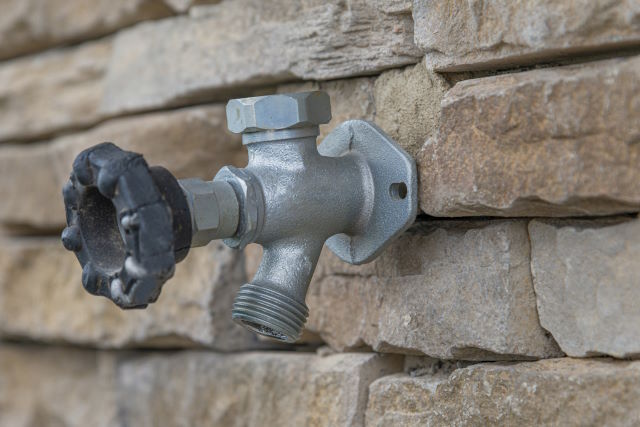
However, hoses can also come in other sizes, such as 1/2-inch, 5/8-inch, and 1-inch, depending on your specific needs.
How To Measure Your Hose Diameter?
To measure a hose’s diameter, simply use a tape measure to find the distance across the internal opening (for female fittings) or the external threads (for male fittings).
This measurement will help you determine the correct thread size and hose diameter for your specific requirements.
Further information is detailed in our hose diameter measuring guide.
What If Your Hose And Spigot Have Different Thread Sizes?
If your hose and outdoor tap have incompatible thread sizes, you can use a hose adapter to bridge the gap.
Hose adapters come in various sizes and configurations, allowing you to connect hoses and outdoor spigots with different thread types and diameters.
Why Is Hose & Thread Size Important?
Choosing the right size hose and fittings is essential for several reasons:
- Compatibility: Properly sized fittings ensure a secure, leak-free connection between your hose and faucet or attachment.
- Water Flow: The size of your hose and fittings can directly affect the water flow and pressure, impacting the efficiency and effectiveness of your watering tasks.
- Ease of Use: Using the correct size hose and fittings can make your watering tasks more manageable and enjoyable, reducing the likelihood of frustration and wasted time.
Conclusion
Understanding garden hose thread sizes and fittings are essential for choosing the right hose for your needs.
By following the steps outlined in this article, you can ensure that you select a hose with the correct fittings, enjoy optimal water flow, and avoid frustrating leaks and incompatibilities. Happy watering!
FAQs
What is the standard garden hose thread size?
The standard thread size for most garden hoses is 3/4-inch GHT.
How can I measure my garden hose fitting size?
To measure your garden hose fitting size, use a ruler or tape measure to find the external diameter (for male fittings) or the internal diameter (for female fittings) of the threads.
What materials are commonly used for garden hose fittings?
Garden hose fittings can be made from various materials, including brass, plastic, and stainless steel. Each material has advantages and disadvantages in terms of durability, corrosion resistance, and cost.
Can I connect a hose with a different thread size to my faucet?
You can use a hose adapter to connect hoses and faucets with different thread sizes. Hose adapters come in various sizes and configurations, allowing for compatibility between different thread types and diameters.
Why is it important to choose the right size hose and fittings?
Choosing the right size hose and fittings is important for compatibility, optimal water flow and pressure, and ease of use. The correct size ensures a secure, leak-free connection and allows you to accomplish your watering tasks efficiently.
